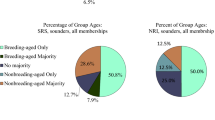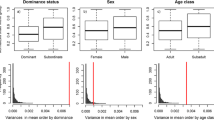Summary
-
1.
Social structure of hourse mouse (Mus musculus L.) populations in quarter-acre (0.1-ha) enclosures was organized differently with respect to centralized and decentralized food (corn) sites. Analysis of social structure indicated a well defined demic organization in populations containing a single, centralized food depot, whereas social structure in decentralized grids was more flexible.
-
2.
A newley-derived dominance index, based on urinary marking patterns, indicated that social dominants were associated with food site location. Subordinate males were less likely to be trapped at food sites in centralized grids than were dominants; subordinate males were excluded to a lesser extent from food sites in decentralized grids.
-
3.
Standard pairing experiments upon termination of the study substantiated that dominant males had significantly higher urinary marking patterns than subordinate males.
Similar content being viewed by others
References
Anderson PK (1970) Ecological structure and gene flow in small mammals. Symp Zool Soc (Lond) 26:299–325
Anderson PK, Hill JL (1965) Mus musculus: Experimental induction of territory formation. Science 148:1753–1755
Barrett GW (1968) The effects of an acute insecticide stress on a semienclosed grassland ecosystem. Ecology 49:1019–1035
Berry RJ (1978) Genetic variation in wild house mice: Where natural selection and history meet. Am Sci 66:52–60
Bronson FH (1973) Establishment of social rank among grouped male mice: Relative effects on circulating FSH, LH and corticosterone. Physiol Behav 10:947–951
Bronson FH (1974) Pheromonal influences on reproductive activities in rodents. In: Birch MC (ed) Phenomones. Elsevier/Excerpta medica/North-Holland, Amsterdam
Bronson FH, Caroom D (1971) Preputial gland of the male mouse: Attractant function. J Reprod Fertil 25:279–282
Bronson FH, Desjardins C (1974) Relationships between scent marking by male mice and the pheromone-induced secretion of the gonadotropic and ovarian hormones that accompany puberty in female mice. In: Montagna WW, Sadler W (eds) Reproductive behavior. Plenum, New York
Brown RZ (1953) Social behavior, reproduction and population changes in the house mouse (Mus musculus L.). Ecol Monogr 23:217–240
Butler RG (1980) Population size, social behaviour, and dispersal in house mice: A quantitative investigation. Anim Behav 28:78–85
Calhoun JB (1949) A method for self-control of population growth among mammals living in the wild. Science 109:333–335
Calhoun JB (1952) The social aspects of population dynamics. J Mammal 33:139–157
Calhoun JB (1962) Population density and social pathology. Sci Am 206:139–148
Cheal ML, Sprott RL (1971) Social olfaction: A review of the role of olfaction in a variety of animal behaviors. Psychol Rep 29:195–243
Chipman RK, Albrecht ED (1974) The relationship of the male preputial gland to the acceleration of oestrus in the laboratory mouse. J Reprod Fertil 38:91–96
Christian JJ (1970) Social subordination, population density and mammalian evolution. Science 168:84–90
Crowcroft P (1955) Territoriality in wild house mice, Mus musculus L. J Mammal 36:299–301
Crowcroft P, Rowe FP (1963) Social organization and territorial behavior in the wild house mouse. Proc Zool Soc (Lond) 140:517–531
DeFries JC, McClearn GE (1970) Social dominance and Darwinian fitness in the laboratory mouse. Am Nat 104:400–411
DeFries JC, McClearn GE (1972) Behavioural genetics and the fine structure of mouse populations: A study in microevolution. Evol Biol 5:279–291
DeLong K (1967) Ecology of feral house mice. Ecology 48:611–634
Desjardins C, Maruniak JA, Bronson FH (1973) Social rank in house mice: Differentiation revealed by ultraviolet visualization of urinary marking patterns. Science 182:939–941
Flowerdew JR (1974) Field and laboratory experiments on the social behavior and population dynamics of the wood mouse (Apodemus sylvaticus). J Anim Ecol 43:499–511
Grant EC, Mackintosh JH (1963) A comparison of the social postures of some common laboratory rodents. Behaviour 21:246–259
Johnson RP (1973) Scent marking in mammals. Anim Behav 21:521–535
Jones RB, Nowell NW (1974) Effects of androgen on the aversive properties of male mouse urine. J Endocrinol 60:19–25
Krebs CJ (1964) The lemming cycle at Baker Lake, Northwest Territories; during 1952–1963. Arct Inst Tech 15:1–104
Krebs CJ (1978) Agression dispersal, and cyclic changes in populations of small rodents. Adv Study Commun Affect 4:49–60
Krebs CJ, Myers JH (1974) Population cycles in small mammals. In: MacFadyen A (ed) Advances in ecological research, vol 8. Academic Press, New York, pp 267–399
Lloyd JA (1975) Social structure and reproduction in two freely growing populations of house mice (Mus musculus L.). Anim Behav 23:413–424
Lloyd JA, Christian JJ (1969) Reproductive activity of individual females in three experimentally freely growing populations of house mice (Mus musculus L.). J Mammal 50:49–59
Mackintosh JH (1970) Territory formation by laboratory mice. Anim Behav 18:177–183
Mackintosh JH (1973) Factors affecting the recognition of territory boundaries by mice (Mus musculus). Anim Behav 21:464–471
Mackintosh JH, Grand EC (1966) The effect of olfactory stimuli on the agonistic behavior of labortory mice. Z Tierpsychol 23:584–587
Macrides F, Bartke A, Calterio D (1975) Strange females increase plasma testosterone levels in male mice. Science 189:1104–1106
Maruniak JA, Owen K, Bronson FH, Desjardins C (1974) Urinary marking in male house mice: Responses to novel environmental and social stimuli. Physiol Behav 12:1035–1039
Maruniak JA, Owen K, Bronson FH, Desjardins C (1975) Urinary marking in female house mice: Effects of ovarian steroids, sex experience, and type of stimulus. Behav Biol 13:211–217
McLaren I (1971) Natural regulation of animal populations. Atherton Press, New York
Mugford RR (1974) Androgenic stimulation of aggression eliciting cues in adult opponent mice castrated at birth, weaning or maturing. Horm Behav 5:93–102
Myers J (1974) Genetic and social structure of feral house mouse population on Grissly Island, California. Ecology 55:747–759
Newsome AE (1969) A population study of house mice permanently inhabiting a reed-bed in South Australia. J Anim Ecol 38:361–377
Newsome AE (1970) An experimental attempt to produce a mouse plague. J Anim Ecol 39:299–311
Oakeshott JG (1974) Social dominance, aggressiveness and mating success among male house mice (Mus musculus). Oecologia (Berl) 15:143–158
Petrusewicz K, Andrzejewski R (1962) Natural history of a free living population of house mice (Mus musculus L.) with particular reference to groupings within populations. Ekol Pol [A] 10:85–122
Phillips EA (1959) Methods of vegetation study. Holt, Rhinehart and Winston, New York
Poole TB, Morgan HDR (1976) Social and territorial behaviour of laboratory mice (Mus musculus L.) in small complex areas. Anim Behav 24:476–480
Ralls K (1971) Mammalian scent marking. Science 171:443–449
Reimer JD, Petras ML (1967) Breeding structure of the house mouse, Mus musculus, in a population cage. J Mammal 48:88–99
Reynolds E (1971) Urination as a social response. Science 234:481–483
Ropartz P (1968) The relation between olfactory stimulation and aggressive behavior in mice. Anim Behav 16:97–100
Schaffer WM (1973) changing reproductive rates and population cycles in lemmings and voles. Evolution 27:111–124
Scott TW, Pfaff DW (1970) Behavioral and electrophysiological responses of female mice to male urine odors. Physiol Behav 5:407–411
Southwick CH (1955) The population dynamics of confined house mice supplied with unlimited food. Ecology 36:212–225
Stoddart MD (1974) The role of odor in the social biology of small mammals. In: Birch MC (ed) Pheromones. Elsevier/Excerpta Medica/North-Holland, Amsterdam
Strecker RL (1955) Populations of house mice. Sci Am 193:92–100
Stueck KL (1976) Effects of resource partitioning on the population dynamics and energy utilization strategies of feral house mice (Mus musculus L.) populations under experimental field conditions. MSci thesis, Miami University, Oxford, Ohio
Stueck KL, Barrett GW (1978) Effects of resource partitioning on the population dynamics and energy utilization strategies of feral house mice (Mus musculus L.) populations under experimental field conditions. Ecology 59:539–551
Suttman CE, Barrett GW (1979) Effects of sevin on arthropods in an agricultural and an old-field plant community. Ecology 60:628–641
Wilson EO (1975) Sociobiology: The new synthesis. Belknap Press of Harvard University, Cambridge, Massachusetts
Wynne-Edwards VC (1965) Social organization as a population regulator. Symp Zool Soc (Lond) 14:173–178
Author information
Authors and Affiliations
Rights and permissions
About this article
Cite this article
Noyes, R.F., Barrett, G.W. & Taylor, D.H. Social structure of feral house mouse (Mus musculus L.) populations: Effects of resource partitioning. Behav Ecol Sociobiol 10, 157–163 (1982). https://doi.org/10.1007/BF00299679
Received:
Accepted:
Issue Date:
DOI: https://doi.org/10.1007/BF00299679




